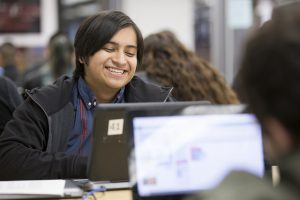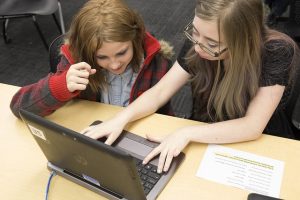East Shares “Secrets” of New AP Computer Class
The notion of secrecy used to be almost implicit in the word code. Not anymore. In fact, there is a concerted effort underway to let as many people as possible in on the code. A new-this-year AP course is evidence of that.
“The College Board has a new Advanced Placement course that we have started at both East and Central Academy,” said the district’s AP Coordinator, Amber Graeber. “It’s an intro level computer science course and the teachers and students are really enjoying it.”
AP Computer Science Principles is taught at East by Tim Walljasper. Thursday afternoon an event took place there as part of Computer Science Education Week that he hopes will attract more students to the class. It was called the Hour of Code and was one small byte of a global movement reaching tens of millions of students in 180+ countries. There are more than 150k such events held annually around the world. But not enough of them are in the United States where too few schools offer curricula in computer science, the ABCs of the 21st century.

East junior Miguel Perez Thursday’s Hour of Code event for a friendly competition in code-writing. Brandon plans to study computer science in college.
Joe Spiess is a School Improvement Leader at East and he seized the opportunity last spring when the College Board announced the rollout of AP Computer Science Principles. Let’s go for it, he said to principal Leslie Morris, and she agreed. Then he went to the school’s math staff looking for a volunteer to teach the class. Walljasper raised his hand and trained for the assignment over the summer in Illinois. Almost 30 students registered to take the course and it’s earning high marks from them so far.
Brandon Mohne and Miguel Perez are juniors at East and they used Thursday’s Hour of Code event in the school library for a friendly competition in code-writing. Brandon plans to study computer science in college so he leapt at the chance to get started when he heard about the class. Miguel describes it as “probably the funnest one I’m taking.”
Spiess saw offering the class as a chance to carve a niche for a segment of students who lacked other built-in lures to school: gamers.
“We thought it would be something to engage kids who maybe weren’t being engaged by anything else; whose interests weren’t being addressed,” he said. “And besides, what could be more relevant to be teaching in this day and age than computer science? This class is considered an elective but our ultimate goal is to get the state to recognize it as one of the math credits required for graduation.”
That would seem like the proverbial no-brainer, especially given that nearly 100 colleges and universities have already indicated their intention to award credits in computer science to students who score well on the AP exam in that area.
Walljasper is otherwise an algebra teacher who sees the experience as a learning opportunity for him too, one that he is sharing with his colleagues as he goes.
“Yes, they are curious about how it’s going and I am excited about that. We’ll need more teachers as the student interest level grows,” he said.
And it already is.
“Oh yeah, we recommend the class to our friends all the time,” said Miguel. Naturally – next semester (it’s a one-year course) every student gets to design their own app.
In development since 2008, AP Computer Science Principles was created in collaboration with the National Science Foundation. The College Board worked with leading computer science educators who piloted the course at their institutions. Similarly, the annual H of C campaign has the backing of tech giants like Microsoft, Apple and Amazon.
It started as a brief introduction to computer science, designed to show that anybody can learn the basics and broaden interest in the field. It has since mushroomed into a worldwide effort supported by over 400 corporate/community partners and 200,000 educators worldwide.
Most of the group that filled the upstairs computer center in the East library after school yesterday are not currently enrolled in the trail-blazing course. But a sheet placed by each computer that listed a menu of online activities for the event ranging from artistic design to sports gaming suggested that students who enjoyed themselves consider registering to take AP Computer Science Principles next year.
Enough attended to clean out the pizzas that were provided, prompting Walljasper to promise a couple of late arrivals that, “I owe you.”
Downstairs, an empty desktop was nearly covered by an almost completed but unattended jigsaw puzzle that depicted a pastoral scene with a horse and buggy. Nothing could have been further from what everyone was doing up above.
The secret is out.





